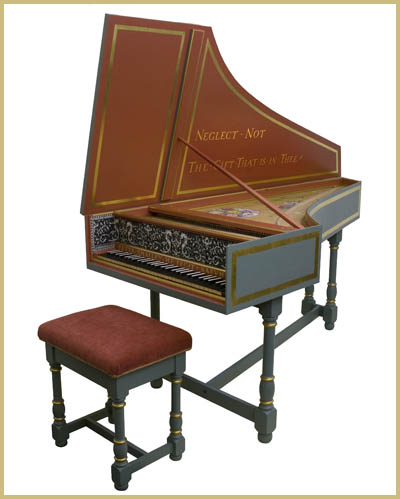
Baroque Instruments
Strings
All Baroque members of the violin family use gut strings (or covered gut for the lower strings). The neck is shorter and square to the instrument compared to the modern violin which leans back.
Inside the body of the violin the baroque instrument has a lighter soundpost and bass bar, and on the front, the bridge is slightly flatter.
The ‘cello has no endpin as it is held between the player’s legs. The bow is straighter, giving a clearer articulation than the modern in-curved bow established by Tourte.
The violin may be held lower on the shoulder, with less grip between chin and shoulder.
The left hand uses vibrato sparingly, generally as an ornament, and bow strokes, articulation and the musical shaping of the shorter motifs characteristic of Baroque music are the important musical elements that make the baroque sound so special.
Woodwind
The instruments are wooden, with fewer keys compared to a modern instrument, which makes the chromatic notes more difficult to tune, as well as giving these notes a special quality, different from the more open notes, where cross-fingering is not used. This is particularly noticeable on the flute.
The bore of the double reed oboe and bassoon is wider, giving a timbre that is designed to blend with the baroque strings, rather than to contrast with them, as in the modern orchestra. This is why Baroque composers often double oboes with violins, bassoons with cellos.
Brass
All early brass instruments are natural; that is, having no valves to artificially alter the pitch of the harmonic series. Thus horns have a selection of "plug-in" crooks in various keys to enable them to play their more limited range of notes in the required key.
Natural trumpets, usually only in D, are able to obtain a greater range of notes only in their highest register.
Pitch and Tuning
Salisbury Baroque uses the pitch which was generally current in later Baroque music, which is a semitone below our modern pitch, at A=415 Hz., rather than 440 Hz. This gives a warmer overall sound, with less tension on the strings. This pitch is a compromise, as French pitch was even lower, as was English pitch in the 17th century. Pitch in early 17th century Italy, however, is thought to be about a semitone higher than modern pitch!
The group plays to a harpsichord tuned in a baroque circular temperament (where the distance between each semitone is different), rather than the equal temperament of the modern piano and wind instruments (where each semitone is identical). Baroque composers found equal temperament to be out of tune, so they used a tuning that was purer in the standard keys, though it could produce interesting colours in the remoter keys.
Baroque Keyboard Development
When listening to a piece of music, the artists that one is immediately aware of are normally the performing musicians and the composer of the piece. However, there is a third person involved in the process – the instrument maker(s). The Baroque period was a very exciting time for makers, as many orchestral instruments went through dramatic development during these times. Composers were usually very quick to make use of these developments, such as the addition of valves on brass instruments and extra keys on woodwind instruments.
 The main keyboard instrument of the period was of course the harpsichord, either as a solo instrument, accompanying other instrument(s) or playing continuo with an orchestra.
The main keyboard instrument of the period was of course the harpsichord, either as a solo instrument, accompanying other instrument(s) or playing continuo with an orchestra.
The keyboard of the early Baroque usually had a compass of around 4 octaves, but by the end of the period this had grown to 5 octaves. This raises an interesting “chicken and egg” question; did makers first add extra notes for which there was no music written, or did composers write pieces for which there was no instrument to play them?!
It is fascinating to note that early harpsichords (particularly Flemish instruments of the Ruckers family) were so highly prized that, a century later, French makers would go to the trouble of basically cutting them in half and adding the extra notes required at the time!
This process, called “ravalement”, often involved extending the case, adding to, or remaking, many parts of the action and adding an extra piece of soundboard, complete with painting! It is interesting to note that, even at the time, such instruments were actually valued at twice the price of new instruments made by the very same craftsmen as were carrying out these ravalements. This tempted some makers to make new instruments that appeared to be old instruments that had undergone a ravalement! We might now consider them forgeries, but it was so normal at the time the process was done fairly openly.
By the mid 18th Century the non-expressive plucked sound of the harpsichord was under threat from a new invention which could play “piano e forte”. By replacing the quill plectra of the harpsichord with a hammer and a very clever escapement mechanism, a whole new sound world opened up. Harpsichord makers made a valiant last ditch attempt to compete with the newfangled fortepiano, adding extra registers, different materials for plectra, knee levers for rapid changes of registration and even swell mechanisms. However, the sound and dynamic range of the piano won the day and the composers of the day quickly latched onto it and the Classical period was born.

